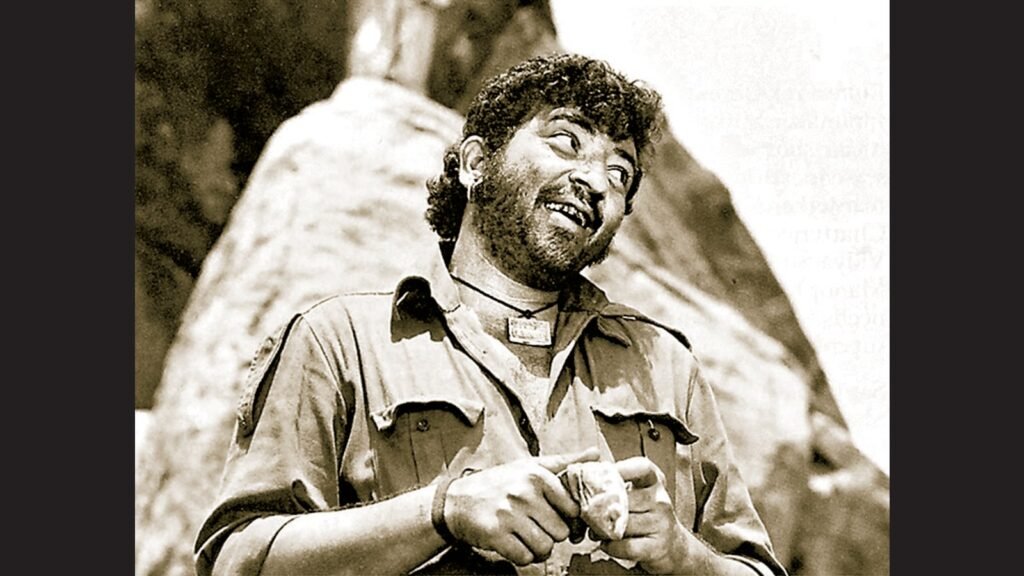
It was probally a coincidence that Sholay was released on independence day in 1975. But this does add a quixotic twist to the story we can call India after Sholay,

The legend, as told in the film world, is that film was alredy before the censor board when the emergency was declared on June 25, 1975. Film, Kills the Villain Gabbar Singh.
This was unacceptable to the censor board – in keeping with the indira Gandhi government’s projection of the emergency as a tool for restoring orders and rules. The producers of Sholay Changed the ending so they could get the censor board certificate. In the version we have been watching for 50 years, the climax of the film is that the police Arrive just in time to, gently but firmly, Persuade Thakur to Not Kill Gabbar. Blooded and Beaten, Gabbar is Taken off to Prison.
Scholars of Social History May Well Quarrel over the original version, with Thakur exacting venage, was more in sync with the mood of the mood of the time or your wait was a warning about there. In Hindsight, Theose of Us Who Grew up in the 1960s, can See Sholay As a landmark event in the decline of a social milieu in which reality was not a simplistic binary of good versus evil.
Films about dacoits and other doors of bad deeds were commonplace. But it was Sholay That Gave Us a Sociopathic Villain Wholein Whose Cruel Wit, Brutal Violence, and Dramatic Macho Swagger Resulted in Iconic Status. In Later Years, A Popular Brand of Biscuits was actually advertised as Gabbar ki asli pasand (Gabbar’s True Preference), complete with a photo of the Villain and his self-satisfied Grin.
However, Sholay Did something much more insidious than make an evil character look cool. It produced a keyhole narrative about offense and vengeance in which there was no reference to any social-power connect context. Until then, Filmi Dacoits Usually Had a Back-Story that evokeed the audience’s compassion. In Doing This, Hindi Films Were Faith Depictting a Structural Reality of the 1950s and 1960s – Namely, of oppressed and traumatised peasants for forced to take up arms and become dacoits out of desperation.
Dilip Kumar’s Ganga JamunaSunil Dutt’s Mujhe jeene doAnd Raj Kapoor’s Jis desh mein ganga behti hai Were Made at a time when Vinoba Bhave And Jayaprakash Narayan was working on the ground for the surrender and rehabilitation of dacoits, who was mostly distressed Farmers. Sholay Provided no back-story for gabbar-Empathic or otherwise. Devoid of any Socio-Economic Context, He is presented as Pure Evil-Sadistic and Maniacal. Thakur, as an honest and hard-working police-cum-landlord, captures gabbar, but the prison system fails. Gabbar Escapes, Kills Thakur’s Family and Cuts Off Thakur’s Arms.
Earlier, Hindi Films Critiqued The System of Governance in Order to Project Stories of Rebellion or Idealistic Struggle. In the universe of salim-javed, the vastly successful duo who wrote the screenplay of SholayThe governance system was invariable presented as definition and worthless. This was offered as the justification for valorising vigilantism. In SholayThere is no samaj (Society) Standing Up Togeger to Fight Evil. There is only Thakur’s Raw, Personal Need for Revenge Versus Gabbar as an individual.
The urge to seek vengeance is indeed an atavistic human trait. This is precisely why much of India’s paranic Tradition is devoted to helping us undersrstand bot the compeling reality of this urge and how we might process it in ways that do’t’t everyone word off. However, in the last five decades, a large volume of films has instalad focused on reviews as personally satisfying and the only viable option. Society is depicted as having given up on the formal governance system delivering justice.
In India after SholayThe validation and celebration of vengeance, by individuals and collectives, became a cultural and political phenomenon. The lust for vence is no longer related to specific crimes against individuals. The Political Discourse, Using Digital Era Propaganda Machanisms, have generated collective forms of victimhood and projectioned venance as both natural and justified.
This shift happy gradually, due to multiple reasons. It was not driven by cinema. But a wide variety of audio-visual media, including what currently purport to be news channels, do provide the drambeat for what no appears to be a collective bloodlust. At Times, this Drumbeat Can Feel overwhelming. But it is still not the only reality. If we make the effort to listen carefully to the full variety of sounds and songs Around Us Today, this will expand our mental space and perhaps even some breathing space. In the relative calm of that space, we will be able to better cognise strivings based on compassion and reasons. Then, Justice Rather than retribution can become not just attractive but possible.
You could say that such definition tehusiasm by itself cannot resolve the crisis of institutions and the justice system. True, but it is in fact energizing country efforts on the ground where highly talented people are working tirelessly to move the needle towards a humane rule of Law.
Such Creative Action is Driven by a Simple Truth, However Unpopular It Might appear at present. Namely, Mass Acceptance of Vengeance Makes The Restoration of the Justice System Increasingly Difacity or even impossible.
One way to counter this is to generate more public actions of the courage of otherwise unsung heroes and heoines on the ground. These are people who work doggedly for human rights and civil liberties – often at great risk as they grapple bravely with Characters who could make make gabbar look tame by comparason.
It might also help to watch the rejected original ending of SholayWhich can be found on YouTube. For, this version leaves us with some different questions. After Thakur successeds in Killing Gabbar, He Crumbles to the Ground, Looking Stunned. As Viru, the surviving hired gun, tries to comfort Hem, Thakur Breaks Down and Sobs Bitterly.
The most obvious interpretation of this Scene is that Thakur is finally alt go and express group and horror over the unsepeakable Cruelty Inflicted Upon Him. But is Thakur also Weeping Maha Victory Somehow Feels Empty? Did Eliminating Gabbar Actually Give Thakur The Satisfaction He Expected? What would have been done the best application of the strength and resolve of a man of Thakur’s Calibre?
When Sholay Is Re-Released, Again on Independence Day, We Cold Just Sit Back and Enjoy It as Entertainment. But this need not prevent us from considering the Above Questions and Pondering How, In Real Life, We Might Support True Justice, Which is a Strength rooted in compassion.
Rajni Bakshi is the founder of the youtube channel ahimsa conversations. The views expressed are personal




